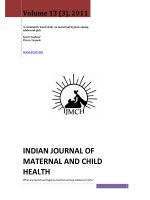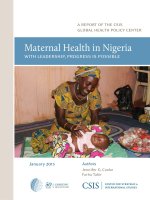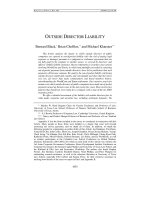California potx
Bạn đang xem bản rút gọn của tài liệu. Xem và tải ngay bản đầy đủ của tài liệu tại đây (872.89 KB, 258 trang )
This PDF document was made available
from
www.rand.org as a public service of
the RAND Corporation.
6
Jump down to document
Visit RAND at www.rand.org
Explore RAND Education
View document details
This document and trademark(s) contained herein are protected by law
as indicated in a notice appearing later in this work. This electronic
representation of RAND intellectual property is provided for non-
commercial use only. Permission is required from RAND to reproduce, or
reuse in another form, any of our research documents.
Limited Electronic Distribution Rights
For More Information
CHILD POLICY
CIVIL JUSTICE
EDUCATIO
N
ENERGY AND ENVIRONMENT
HEALTH AND HEALTH CAR
E
INTERNATIONAL AFFAIR
S
NATIONAL SECURIT
Y
POPULATION AND AGIN
G
PUBLIC SAFETY
SCIENCE AND TECHNOLOGY
SUBSTANCE ABUSE
TERRORISM AND
HOMELAND SECURITY
TRANSPORTATION AND
INFRASTRUCTURE
The RAND Corporation is a nonprofit
research organization providing
objective analysis and effective
solutions that address the challenges
facing the public and private sectors
around the world.
Purchase this document
Browse Books & Publications
Make a charitable contribution
Support RAND
This product is part of the RAND Corporation monograph series.
RAND monographs present major research findings that address the
challenges facing the public and private sectors. All RAND mono
-
graphs undergo rigorous peer review to ensure high standards for
research quality and objectivity.
Stephen J. Carroll, Cathy Krop, Jeremy Arkes,
Peter A. Morrison, Ann Flanagan
Supported by the William and Flora Hewlett Foundation
California’s K–12
Public Schools
How Are They Doing?
The RAND Corporation is a nonprofit research organization providing
objective analysis and effective solutions that address the challenges
facing the public and private sectors around the world. RAND’s
publications do not necessarily reflect the opinions of its research clients
and sponsors.
R
®
is a registered trademark.
© Copyright 2005 RAND Corporation
All rights reserved. No part of this book may be reproduced in any
form by any electronic or mechanical means (including photocopying,
recording, or information storage and retrieval) without permission in
writing from RAND.
Published 2005 by the RAND Corporation
1776 Main Street, P.O. Box 2138, Santa Monica, CA 90407-2138
1200 South Hayes Street, Arlington, VA 22202-5050
201 North Craig Street, Suite 202, Pittsburgh, PA 15213-1516
RAND URL: />To order RAND documents or to obtain additional information, contact
Distribution Services: Telephone: (310) 451-7002;
Fax: (310) 451-6915; Email:
Library of Congress Cataloging-in-Publication Data
California’s K–12 public schools : how are they doing? / Stephen J. Carroll [et al.].
p. cm.
“MG-186.”
Includes bibliographical references.
ISBN 0-8330-3716-1 (pbk. : alk. paper)
1. Public schools—California. 2. Education—California—Evaluation. 3.
Educational equalization—California. 4. Education and state—California. I.
Carroll, Stephen J., 1940–
LA243.C34 2005
371.01'09794—dc22
2004025761
The research described in this report was conducted by RAND
Education for the William and Flora Hewlett Foundation.
iii
Foreword
Jorge Ruiz-de-Velasco and Marshall S. Smith
The William and Flora Hewlett Foundation
This RAND report carefully documents how California’s public
schools have declined in quality along many important dimensions
since the 1970s. Moreover, the investigators report a growing, if
somewhat vague, awareness among Californians that the quality of
our public schools has slipped both relative to the past, as well as to
schools in other states. Yet, despite this growing awareness, it is fair to
say that there has been little sense of urgency among voters about the
condition of our schools. Even as an enormous revenue shortfall in
the spring and summer of 2003 forced state and local districts to
make large cuts in school budgets, media and public attention to the
problems facing our schools has been scant or localized. The danger
now, as in previous budget crises, is that leaders will look for short-
term solutions in the hope that the economy turns around quickly
enough to keep them from having to make hard reform choices.
Why the complacency at the state level about the quality of our
schools? We believe the problem is two fold. First, although the state
collects a great deal of data about student performance and the distri-
bution of resources to schools, these data are difficult and costly for
reporters and even professional policy analysts to obtain and synthe-
size. Consequently, journalists and others rely on local reports about
individual schools or groups of schools or even about individual stu-
dents to tell the story. The result is that attentive citizens get a
glimpse of heroic teachers and stalwart students struggling to teach
and learn in decrepit schools that lack books, certified teachers, or
functioning bathrooms. The take-away has often been a recognition
that things in some schools are pretty bad, but no real sense of the
iv California’s K–12 Public Schools: How Are They Doing?
scope of the crisis across the state in general. In this context, it has
been easy for voters and leaders to minimize the situation and to seek
only short-term solutions, or to target only the offending schools for
improvement.
A second explanation for public complacency involves the old
rule that a problem with no apparent solution (or consensus about a
solution) is generally not defined as a problem. Instead it comes to be
accepted as “just the way things are.” In the case of schools there
has been little attention paid to the yawning gap between our high
curriculum standards and the inadequate resources we provide to
schools, in part because state leaders have been divided about the
scope of the problem or about the proper solution when the problem
is acknowledged. In this ambiguous context only stakeholders (teach-
ers and sometimes parents) get involved in the political fray while the
confused public tunes out.
In response, the William and Flora Hewlett Foundation
launched a multi-year effort, begun in 2002, to address the two
problems we have just outlined. This study is the most recent product
in an effort to gather, analyze, and broadly disseminate information
about the status of public education across the state. Our hope is that
studies like this will provide important context for all those individual
investigations of local schools by giving Californians and our policy
leaders reliable information about the scope of the challenges facing
our teachers and students in virtually every California school district.
We hope that these studies will do more than just define the
challenges we face, but will also underscore lessons learned and point
the way to solutions and policy options that would have wide appeal
to voters and school stakeholders across the state. Indeed some of
those solutions have been suggested in the following pages. The re-
port, for example, concludes that California students rank among the
lowest in the nation in student achievement, and that this is consis-
tently true across all racial and ethnic groups. One source of this
problem is that California’s accountability system provides school
leaders with an end-of-the-year snapshot of how the school per-
formed, but does not provide data in a time and manner that could
be used by teachers and principals for continuous improvement. By
Foreword v
contrast, states with similar demographics, like Texas, have made
more robust progress on student achievement because their account-
ability systems provide multiple opportunities for teachers to assess
student progress on meeting state standards and, potentially, to make
mid-course corrections. Our accountability system needs to move in
this direction before we can hope to begin closing the achievement
gap with other states.
The RAND report also suggests that the time is right for Cali-
fornians to rethink Proposition 98, which was intended to establish a
minimum funding formula for schools, but which has come to func-
tion more as a funding ceiling than a floor. Despite the good inten-
tions behind Proposition 98, the RAND report documents continu-
ing inequalities in the resources—both capital and human—available
to schools in poor communities with large concentrations of African-
American and Latino students. The inequalities represent a moral—
and arguably a state constitutional—problem. The issues are simple
to understand. Is it fair that schools with our highest poverty students
also have the poorest resources? Should schools that do not have suf-
ficient resources to succeed be held accountable for goals that require
success? Shouldn’t all students have a fair chance to succeed? These
questions are currently before the California courts in Williams v.
State of California, and it is important that state leaders step up to the
plate and find a fair and equitable solution to the legal complaint out
of court.
Moreover, the poor performance and often shaky financial con-
dition of schools in even well off communities calls into question the
fundamental adequacy of our school finance system across the board.
To be fair, over the last seven years the state has attempted to address
these problems by decreasing class size, providing money for teacher
training, and holding schools accountable for student achievement.
The result is that test scores have increased. But even with the gains,
in the latest national assessments every group of our students (whites,
Asian, Hispanic, and African American) fall below the national aver-
age for similar groups in other states. A different approach is needed.
Coming up with more effective solutions will be the central charge of
the new bipartisan California State Quality of Education Commis-
vi California’s K–12 Public Schools: How Are They Doing?
sion. It is our hope that this and other studies will help the fledgling
Commission square our school accountability system with a new fi-
nance system that together provide the incentives and resources
schools really need to help all California students meet the state per-
formance standards.
vii
Preface
As recently as the 1970s, California’s public schools were considered
to be among the nation’s best. Today, however, there is widespread
recognition that the schools are no longer top performers. As a conse-
quence, many Californians share a growing sense of alarm about the
ineffectiveness of their public education system and the generation of
children whose educational needs are not being met.
Researchers at the RAND Corporation examined California’s
system of kindergarten through grade 12 (K–12) public schools on
several dimensions, including student achievement and other student
outcomes that schools may influence, as well as school finances,
teachers, and facilities. Their goal was to describe the state of Califor-
nia’s K–12 public schools, not to pinpoint why schools are in the
shape they are or to advocate solutions (except where one seemed ob-
vious from their findings). This descriptive report should be of inter-
est to policymakers at the state and federal levels and to educators,
especially in California. Parents may also benefit from the informa-
tion it provides.
This research was conducted within RAND Education, a divi-
sion of the RAND Corporation, with support from the William and
Flora Hewlett Foundation. The statements made and views expressed
are solely the responsibility of the authors.
ix
Contents
Foreword iii
Preface
vii
Figures
xiii
Tables
xix
Summary
xxiii
Acknowledgments
xxxix
CHAPTER ONE
Background, Scope, and Organization 1
This Study
2
K–12 Reforms in California
4
School Finance Reform
4
Class Size Reduction
5
Charter Schools
7
Vouchers and Open Enrollment
7
High-Stakes Testing and Accountability Systems
8
Report Overview
9
CHAPTER TWO
Demographic Overview of California’s K–12 Public School
Student Population
11
Historical Perspectives
11
Racial/Ethnic Diversity and Fluency in English
12
Age Composition
15
Child Poverty
16
x California’s K–12 Public Schools: How Are They Doing?
Geographic Redistribution 18
School Enrollment
19
Access to Computers and the Internet
22
Conclusions
24
CHAPTER THREE
California’s K–12 Public School Finances 27
Evolution of the Finance System
27
California K–12 Revenues
30
Sources of Public K–12 Revenues
30
Per-Pupil K–12 Revenues
34
Categorical Aid as a Share of K–12 Revenues
39
California K–12 School Expenditures
43
Per-Pupil Expenditures in K–12 Public Schools
44
K–12 School Spending on Various Categories
46
California’s K–12 Funding Capacity and Effort
49
Conclusions
54
CHAPTER FOUR
California’s K–12 Public School Teachers 57
Teachers and Other Staff
57
Profile of Teachers
60
Teachers Without Full Credentials
62
Distribution of Teachers Without Full Credentials
67
Teacher Salaries
72
Pupil-Teacher Ratios
80
Conclusions
84
CHAPTER FIVE
California’s K–12 Public School Facilities 89
Condition of Schools
92
Growth in Construction Expenditures
96
Financing of School Facilities
101
Conclusions
107
Contents xi
CHAPTER SIX
California’s K–12 Public School Student Academic Achievement 109
Data Sources
110
California’s Statewide Testing Programs
110
National Assessment of Educational Progress (NAEP)
113
Results from State Assessments, 1998–2003
117
SAT/9 Results, 1998–2002
117
CAT/6 Results, 2003
119
Performance of Students Disaggregated by Race/Ethnicity
120
Results from NAEP
122
Overall NAEP Scores
122
Performance of Students Disaggregated by Race/Ethnicity
125
Average State NAEP Scores and Family Characteristics
127
Scores for Students from Similar Families
132
Recent NAEP Score Gains
134
Average Gains Adjusted for Family Characteristics
136
California NAEP and SAT/9 Compared
139
Conclusions
140
CHAPTER SEVEN
Other Indicators of Student Progress 143
Teenage Pregnancy
145
Background
145
Teenage Pregnancy in California and Other States
148
Substance Abuse
151
Background
151
Substance Abuse in California and Other States
152
Juvenile Delinquency
155
Background
155
Juvenile Delinquency in California and Other States
156
High School Graduation
158
Background
158
High School Graduation Rates in California and Other States
159
xii California’s K–12 Public Schools: How Are They Doing?
College Continuation 164
Background
164
College Continuation Rates in California and Other States
165
Conclusions
166
CHAPTER EIGHT
Summary and Conclusions 169
Summary
169
Student Population
169
School Funding
171
Teachers
172
School Facilities
173
Student Achievement Outcomes
174
Other Indicators of Student Progress
175
Conclusions
175
APPENDIX
A. Additional California Test Score Data and Analyses 177
B. Data and Methods Used to Describe Nonacademic Indicators
191
Bibliography
201
xiii
Figures
S.1. California’s K–12 Public School Per-Pupil Spending
Relative to the National Average, 1969–1970 to
1999–2000
xxviii
S.2. K–12 Public School Spending as a Percentage of
Personal Income, California and the United States,
1970 to 2000
xxix
S.3. Pupil-Teacher Ratios in K–12 Public Schools, California
and the United States, Fall 1969 to Fall 1999
xxxi
S.4. Cumulative Differences in Per-Pupil Construction
Expenditures Between 1991–1992 and 1999–2000,
California and the United States
xxxii
S.5. Average State Performance on NAEP Reading and
Mathematics, Grades 4 and 8, 1990–2003
xxxiv
2.1. California’s Population, by Race/Ethnicity
13
2.2. Student Population Enrolled in California’s K–12
Public Schools, by Race/Ethnicity
14
2.3. California K–12 Public School Enrollment, 2003 Series
15
2.4. Selected Key Indicators of Child Well-Being, California
and the United States, 1990–2000
17
2.5. Percent Change in K–12 Enrollment, by County,
2002–2012
19
2.6. Computer and Internet Access at Home, United States,
1984–2000
23
2.7. Home Computer and Internet Use Among Children
Ages 3–17, by Race/Ethnicity, United States, 2001
24
xiv California’s K–12 Public Schools: How Are They Doing?
3.1. Sources of Public K–12 Revenues, California, 1977–1978
to 2001–2002
31
3.2. Sources of Public K–12 Revenues, United States,
1977–1978 to 2001–2002
32
3.3. Public K–12 Revenues from Federal, State, and Local
Sources, Five Most Populous States, 2000–2001
33
3.4. Revenues per Pupil, California, 1977–1978 to 2002–2003
(est.), and the United States, 1977–1978 to 2001–2002
35
3.5. Public K–12 Revenue per Pupil, by State, 2001–2002
38
3.6. Public K–12 Revenue per Pupil, Five Most Populous
States, 1990–1991 and 2001–2002
40
3.7. K–12 Proposition 98 Discretionary Spending Share,
1988–1989 to 2000–2001
41
3.8. Current K–12 Public School Expenditures per Pupil,
1969–1970 to 1999–2000, California and the United
States
44
3.9. California’s K–12 Public School Per-Pupil Spending
Relative to the National Average, 1969–1970 to
1999–2000
46
3.10. California’s K–12 Public School Per-Pupil Spending on
Various Expenditure Categories, 1991–1992 and
1999–2000
47
3.11. Change in K–12 Public School Per-Pupil Spending
Between 1991–1992 and 1999–2000, California and
the United States
49
3.12. Per Capita Personal Income, Five Most Populous States,
1999–2000
50
3.13. Relation of K–12 Public School Per-Pupil Spending
to $1,000 Personal Income, Five Most Populous States,
1999–2000
51
3.14. K–12 Public School Per-Pupil Spending as a Percentage
of Personal Income, California and the United States,
1970–2000
53
3.15. Per Capita Spending on Various State Functions,
California and the United States, 1997–1998
54
Figures xv
4.1. Number of Teachers in California’s K–12 Public Schools,
Fall 1969 to Fall 2002
61
4.2. Percentage of First-Year Teachers in California, by
Credential Status
64
4.3. Gap Between Total Number of K–12 Teachers and
Number of Fully Credentialed Teachers in California
Public Schools, 1991–1992 to 2002–2003
65
4.4. Distribution of California’s K–12 Public School Teachers
Without Full Credentials, by Student Poverty Level,
1997–1998 to 2002–2003
70
4.5. Distribution of California’s K–12 Public School Teachers
Without Full Credentials, by Percentage of Minority
Students, 1997–1998 to 2002–2003
72
4.6. Average Annual Salaries of K–12 Public School Teachers,
California, 1969–1970 to 2000–2001
74
4.7. Beginning K–12 Public School Teacher Salaries,
California and the United States, 1990–1991 to
1999–2000
77
4.8. Average K–12 Public School Teacher Salaries for Various
Levels of Earned Degrees and Experience, California
and the United States, 1999–2000
79
4.9. Pupil-Teacher Ratios in K–12 Public Schools, California
and the United States, Fall 1969 to Fall 1999
82
4.10. Pupil-Teacher Ratios in K–12 Public Schools, California
Relative to National Average, 1969–1970 to 1999–2000
83
4.11. Median Pupil-Teacher Ratios in Public Primary, Middle,
and High Schools, California and the United States,
2000–2001
84
4.12. Pupil-Teacher Ratios in K–12 Public Schools, Five Most
Populous States, 1969–1970, 1979–1980, 1989–1990,
and 1999–2000
85
5.1. Percentage of K–12 Public Schools Reporting “Inadequate”
Building Features, the West and the United States,
1994–1995 and 1999–2000
94
xvi California’s K–12 Public Schools: How Are They Doing?
5.2. Percentage of K–12 Public Schools Reporting “Inadequate”
Environmental Factors, the West and the United States,
1994–1995 and 1999–2000
95
5.3. Percent Growth in K–12 Public School Construction
Expenditures and Enrollment, United States, 1991–1992
to 1999–2000
97
5.4. Percent Growth in K–12 Public School Construction
Expenditures and Enrollment, California, 1991–1992
to 1999–2000
98
5.5. K–12 Public School Construction Expenditures per
Pupil, California and the United States, 1991–1992
to 1999–2000
99
5.6. Cumulative Differences in K–12 Public School
Construction Expenditures per Pupil, California
and the United States, 1991–1992 to 1999–2000
100
5.7. Sources of Funds Raised for California’s K–12 Public
School Facilities, 1987–1988 to 1998–1999
103
5.8. California Voter Decisions on Statewide School Bonds,
1982 to 2002
104
5.9. California Voter Decisions on Local School Bonds,
1982 to 2002
105
5.10. Passage of Local Bond Measures in California Before
and After Proposition 39 Took Effect
106
6.1. California SAT/9 Scaled Scores, Mathematics, by Grade,
1998–2002
118
6.2. California SAT/9 Scaled Scores, Reading, by Grade,
1998–2002
119
6.3. Percentage of California Students Scoring At or Above
the 50th National Percentile Rank on CAT/6,
Mathematics, by Race/Ethnicity, 2003
121
6.4. Percentage of California Students Scoring At or Above
the 50th National Percentile Rank on CAT/6, Reading,
by Race/Ethnicity, 2003
122
6.5. Average State NAEP Scores, Reading and Mathematics,
Grades 4 and 8, 1990–2003
128
6.6. Estimated Average State SES Test Scores, 1990–2003
131
Figures xvii
6.7. Estimated Average NAEP Scores for Students from
Similar Families Across States
132
6.8. NAEP Gains for California and the United States,
Mathematics and Reading, Grades 4 and 8,
1990–2003
136
6.9. California Students’ Annualized Gains on NAEP
and SAT/9 for Comparable Test Years
139
7.1. High School Graduation Rates, Five Most Populous
States, 1981–2000
160
A.1. CAP Mean Scaled Scores, Grades 3, 6, and 8,
Mathematics
179
A.2. CAP Mean Scaled Scores, Grades 3, 6, and 8,
Reading
180
A.3. Average State NAEP Scores, Grades 4 and 8,
Mathematics, 1990–2003
185
A.4. Average State NAEP Scores, Grades 4 and 8,
Reading, 1992–2003
185
A.5. Average State NAEP Scores, Grade 4, Reading and
Mathematics, 1992–2003
186
A.6. Average State NAEP Scores, Grade 8, Reading and
Mathematics, 1990–2003
186
A.7. Estimated Average NAEP Scores for Students with
Similar Families, Mathematics
187
A.8. Estimated Average NAEP Scores for Students with
Similar Families, Reading
187
A.9. Estimated Average NAEP Scores for Students with
Similar Families, Grade 4
188
A.10. Estimated Average NAEP Scores for Students with
Similar Families, Grade 8
188
xix
Tables
2.1. Number and Percentage of Related Children Under Age 18
in Poverty in 2000, by Family Type, California and the
United States
16
2.2. Projected California Public K–12 Enrollment, by County
and School Year
20
2.3. School Enrollment in 2000 for Children Ages 3–17,
California and the United States
22
3.1. Comparative Summary of California's K–12 Public School
Finances
55
4.1. Teachers and Other Staff in K–12 Public Schools, United
States and California, 1969–1970 and 1999–2000
58
4.2. K–12 Public School Teachers Without Full Credentials, by
Assignment Area, 1997–1998 and 2002–2003
68
4.3. Percentage of Public School Districts Requiring Various
Teacher Qualifications When Considering Teacher
Applicants, California and the United States, 1999–2000
73
4.4. Average K–12 Public School Teacher Salaries, Adjusted and
Unadjusted, Five Most Populous States and United States,
1999–2000
80
4.5. Summary of Outcomes for California’s K–12 Public School
Teachers
87
5.1. Amount by Which California Trails the Four Other Most
Populous States in K–12 Public School Construction
Expenditures per Pupil, 1991–1992 and 1999–2000
100
xx California’s K–12 Public Schools: How Are They Doing?
5.2. Summary of Outcomes for California’s K–12 Public
School Facilities
108
6.1. California’s Participation in the NAEP, 1990–2003
114
6.2. Average Percentage of California Students Scoring At or
Above the 50th
National Percentile, 2003 120
6.3. Student Performance on NAEP, Difference Between the
United States and California and Difference Between Each
of the Four Other Most Populous States and California,
Mathematics
123
6.4. Student Performance on NAEP, Difference Between the
United States and California and Difference Between Each
of the Four Other Most Populous States and California,
Reading
124
6.5. Student Performance on NAEP, Difference Between the
United States and California and Difference Between Each
of the Four Other Most Populous States and California,
Disaggregated by Race/Ethnicity, Mathematics
125
6.6. Student Performance on NAEP, Difference Between the
United States and California and Difference Between Each
of the Four Other Most Populous States and California,
Disaggregated by Race/Ethnicity, Reading
126
6.7. Demographic and Economic Statistics for California, 1990
and 2000, and California’s National Ranking, 2000
130
6.8. Estimated Annual Gains in NAEP for the Five Most
Populous States, Mathematics and Reading, 1990–2003,
and Mathematics Only, 1990–2003
137
7.1. Annual Pregnancy Rates Across Racial/Ethnic Groups,
United States (per 1,000 15–17 year old females)
146
7.2. Actual and Adjusted Pregnancies, Five Most Populous
States (per 1,000 15–17 year old females)
149
7.3. Annual Change in Actual and Adjusted Births, Five Most
Populous States, 1990–2000 (per 1,000 15–17 year old
females)
150
7.4. Teenage Substance Abuse in California, 1999–2000
154
7.5. Substance Abuse Rates of 12–17 Year Olds, the Five
Most Populous States and the United States
155
Tables xxi
7.6. Juvenile Arrests for Property and Violent Crimes, 2000
(per 10,000 10–17 year olds)
157
7.7. Annual Percent Change in Rates of Juvenile Arrests for
Property and Violent Crimes, 1994–2000
159
7.8. Actual and Adjusted High School Graduation Rates for 2000,
and Annual Trends
161
7.9. Graduation Rates and Rankings, Five Most Populous States
and Six Largest California School Districts, 1998
163
7.10. College Continuation Rates, 1992–2000 Biennial Data
165
7.11. Summary of Outcomes on Other Indicators of Progress for
California Students
167
A.1. Estimated National Percentile Rank of the Median
California Third Grader, Reading, 1967–1986
181
A.2. Average Percentage of California Students Scoring At or
Above the 50th
National Percentile, Mathematics,
1998–2002
182
A.3. Average Percentage of California Students Scoring At or
Above the 50th
National Percentile, Reading, 1998–2002 183
B.1. Adolescent Substance Abuse Rates Across Racial/Ethnic
Groups, 1999–2000
196
xxiii
Summary
As recently as the 1970s, California’s public schools were reputed to
be excellent. Today, that reputation no longer stands. Instead, there is
widespread concern that California’s schools have slipped in quality
over the years and that they are no longer performing as well as they
did previously or as well as schools in other states.
The primary objective of our study was to look closely at Cali-
fornia’s public system of kindergarten through twelfth grade (K–12)
schools in order to provide an accurate, comprehensive picture of the
system as it is today. We describe in this report the student popula-
tion and the schools’ resources, including their financial resources,
teachers, and facilities. We also describe the schools’ outcomes, ini-
tially focusing on student academic achievement as measured by
standardized tests, and then turning to other outcomes that may be
influenced by schools and are not adequately captured in test scores.
These include both educational attainment measures—high school
graduation and continuation on to college—and a variety of non-
academic measures—teenage pregnancy, substance abuse, and juve-
nile delinquency—on the grounds that the purpose of schooling goes
beyond academic achievement to include students’ broader prepara-
tion for adult success and citizenship.
In looking at the student population, the resources, and the
various outcomes, we also analyzed trends and compared California
with other states and to the nation as a whole as much as the data
would allow. In some cases, the data allowed us to focus broadly on
the schools since the 1970s; in other cases, however, the available data









